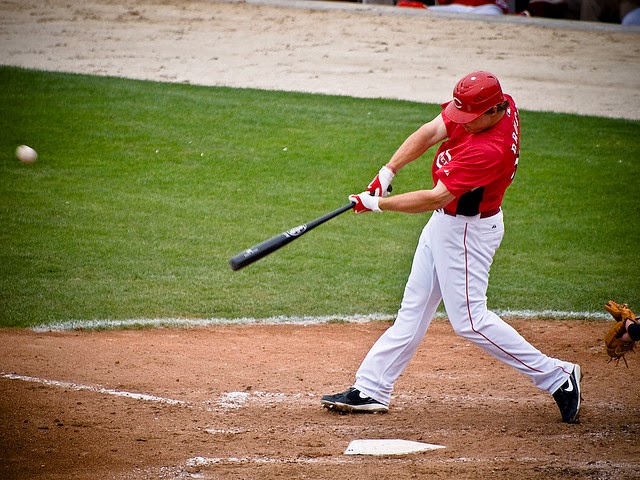The honest truth is that, on paper, the Cardinals just don't really have any weaknesses. They hit, field, start, and relieve as well just about any team in baseball. They're going to be very, very tough this year. But that, of course, is on paper. And it's why we play the games!
Great American Ballpark
I'm not going to routinely preview Great American Ballpark when I do series previews this year. But as this is the first series of the year, I figured I'd give it a moment to shine!Park Factors
Basic Runs: 101
HR (LHB/RHB): 110/114
Great American Ballpark continues to strongly favor the home run, but tends to play as only a slight hitters' park after trending toward a substantial hitters' park in the mid to late 00's. When the ball stays in the park, all types of hits are slightly depressed. But when batters get the ball up in the relatively short power alleys, they can get some fairly easy home runs. In the image above, I compared GABP to the Nationals' park, which plays almost perfectly neutral to both right-handed and left-handed hitters. You can see that the Reds' stadium is very comparable, except in the power alleys in both left and right field.
Hitters
All numbers are projections. The Reds are suffering from the injury bug, which most recently hit Devin Mesoraco and landed the Reds' starting catcher on the DL to start the season with an oblique injury. All reports have been good and we expect a speedy return, but it will not happen by opening day. In the meantime, Tucker Barnhart gets to make his big league debut--at least on the roster. The projections quite like Tucker, showing him an equivalent batter to most everyone on the bench not named Chris Heisey (probably a stretch) and a brilliant defensive player (not at all a stretch). I'm hopeful that the Reds will give him a chance to play while he's here, because it will likely be a short visit.It's hard to do anything but admire what the Cardinals have assembled here. It's not just their starting lineup, which is stacked with talent. They also have an extremely deep bench, with players who, as recently as last season, were starting players on this or other teams. Jon Jay will surely receive a good number of AB's as the 4th outfielder, while Mark Ellis is likely in something like a platoon with Kolten Wong at 2B. Daniel Descalso can play all over as well, though perhaps not with grace. Former PED user Jhonny Peralta somehow became a solid fielder in Detroit. The consensus seems to be that his fielding is overrated a bit by UZR, but he doesn't embarass himself out there. And the guy has been a consistently good hitter. And how about Peter Bourjos? He derives a lot of his value from his fielding and baserunning, but the guy has some hitting prowess as well. If he can stay healthy, the Cardinals should be thrilled with that deal.
So, they're good. Everyone keeps making a big deal about their performance with runners in scoring position last season, and how that's unlikely to happen again this year. Here's the thing, though: they don't need to be special with RISP to have a great offense. They should have a great offense because they are loaded, top to bottom, with good hitters!
Starting Rotations
With Mat Latos still getting back his strength following early spring training knee surgery, the Reds will give Alfredo Simon at least one start. The projection above is for him as a reliever, but the WAR probably isn't too far off--generally, we should add at least a half run to a pitcher's ERA & FIP when he moves from relief to the starting rotation. A 4.4-4.6 ERA would put him in replacement-level territory.
Bullpens
The place where the Reds' injury bug has hurt the most has been the bullpen. Without Chapman and Marshall, the Reds have gone from a stacked bullpen to one that could struggle to finish up games. Still, like I said in my season preview, I'm pretty impressed with Logan Ondrusek's numbers from last season, and I'm comfortable with our top 3. Another consequence of the injuries: without Marshall, the Reds only have one lefty in the entire pen. Bryan Price will have to carefully choose the best spot to deploy Parra.
But as for the rest, I was sort of hoping that the others would have at least shown some recent dominance in the minor leagues. The only one who fit that bill was Trevor Bell (in AA last season). Nick Chrstiani's and Curtis Partch's numbers look pretty pedestrian. Partch was something of a surprise to make the roster, winning the spot at the last minute over Rule 5 draftee Pedro Beato. He throws harder than anyone in the pen (with Chapman out), but seems to have little idea of where it's going.
I don't love the Cardinals' pen as much as I love the rest of their team...but they're still really good. Trevor Rosenthal is a legitimate stud in the back of the pen. Everyone else, aside from maybe the back end of the pen, is capable and formidable. I mean, sheesh, Kevin Siegrist posted a 0.45 ERA last year! He's not likely to do that again, but he struck out 11.3 k/9.
The Cardinals are unquestionably the team to beat this year. But if the Reds want to win the division, they'll just have to be better! Maybe it won't be the most likely outcome, but there are scenarios in which the Reds will top the Cardinals by season's end. Getting off to a good start in this series would make those just a bit more likely.
Play ball!
































